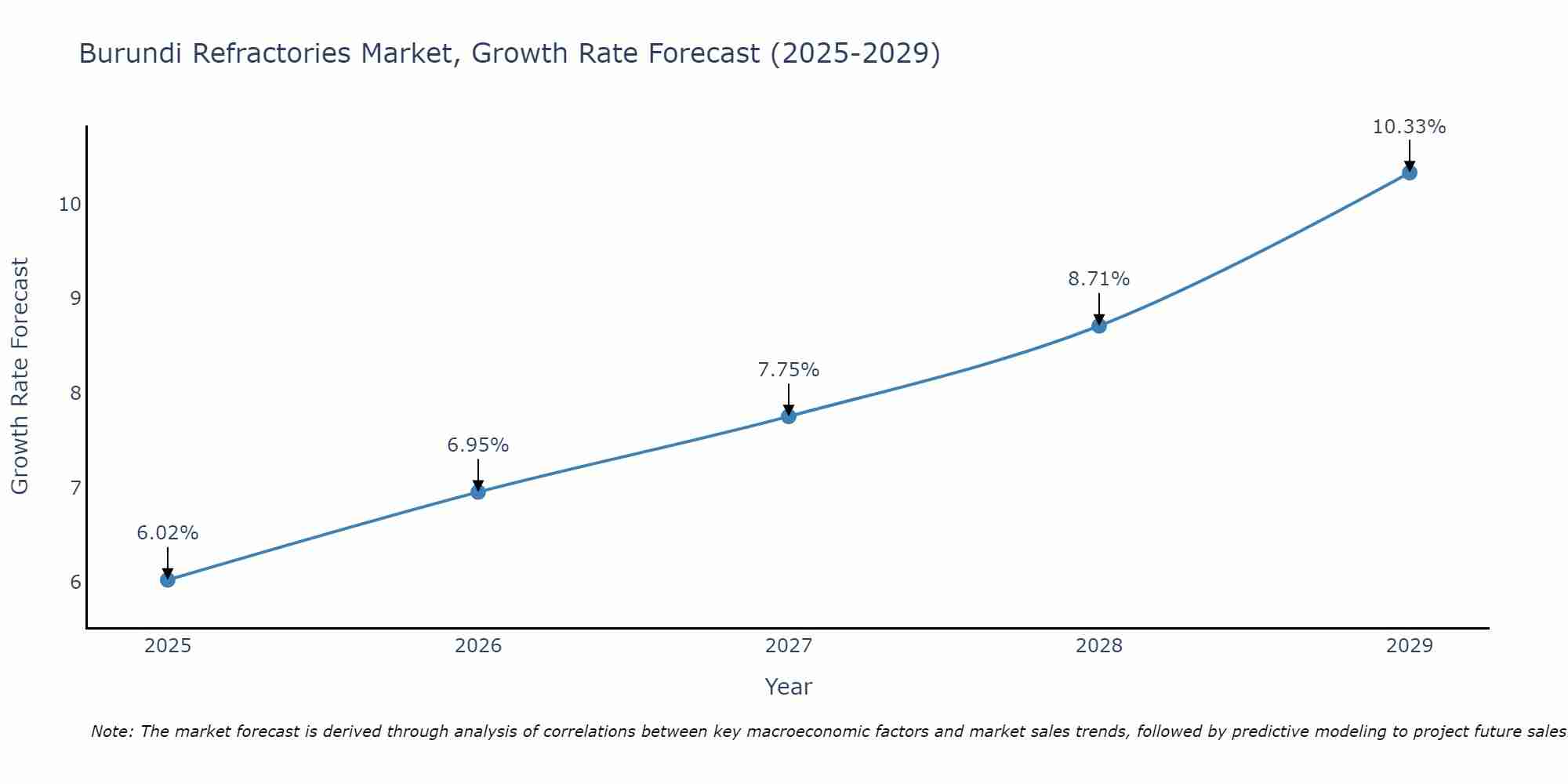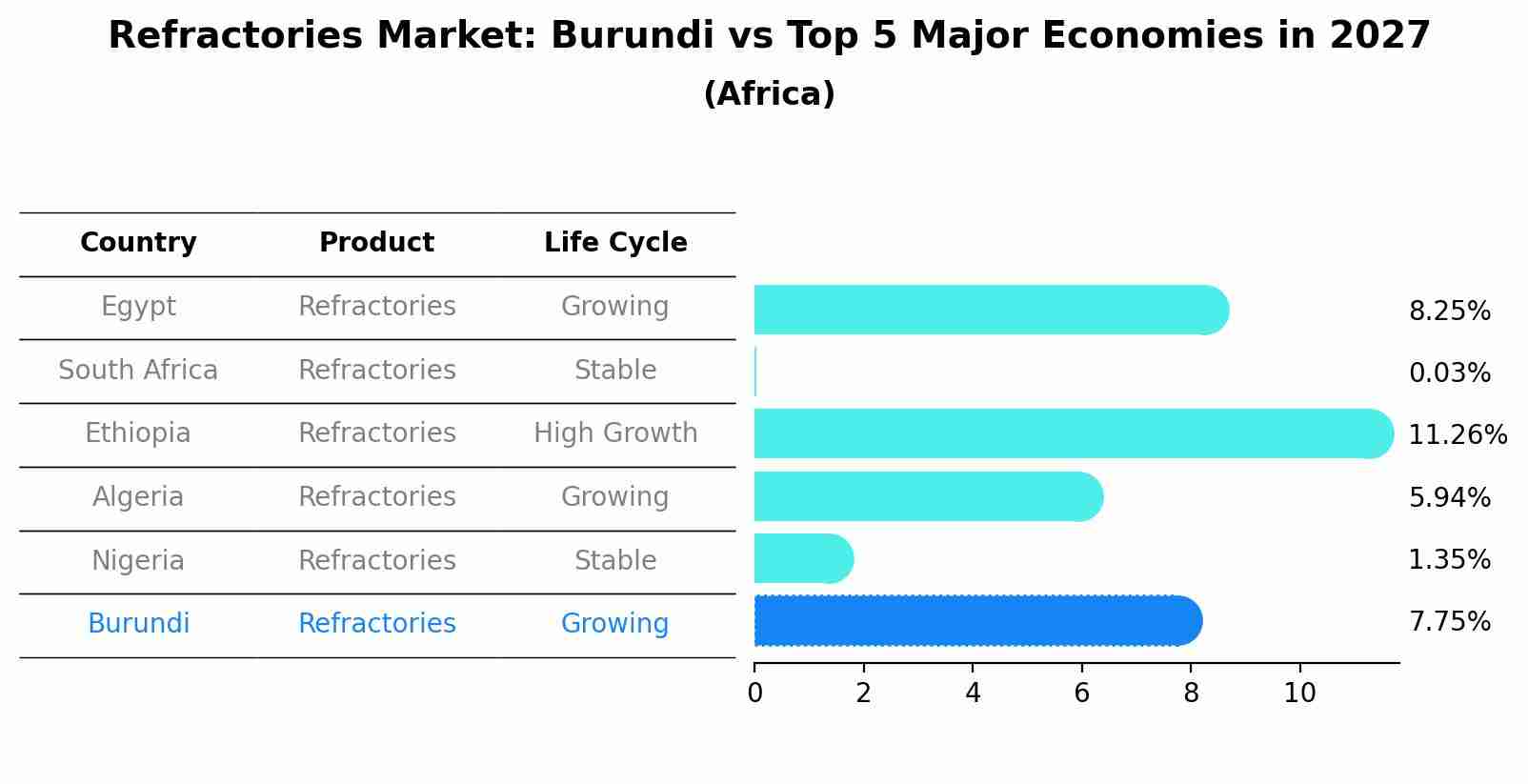Burundi Refractories Market (2025-2031) | Industry, Growth, Share, Segmentation, Revenue, Companies, Size, Value, Outlook, Trends, Analysis & Forecast
| Product Code: ETC4654747 | Publication Date: Nov 2023 | Updated Date: Apr 2025 | Product Type: Market Research Report | |
| Publisher: 6Wresearch | Author: Shubham Deep | No. of Pages: 60 | No. of Figures: 30 | No. of Tables: 5 |
Burundi Refractories Market Size Growth Rate
The Burundi Refractories Market is likely to experience consistent growth rate gains over the period 2025 to 2029. From 6.02% in 2025, the growth rate steadily ascends to 10.33% in 2029.

Refractories Market: Burundi vs Top 5 Major Economies in 2027 (Africa)
By 2027, Burundi's Refractories market is forecasted to achieve a growing growth rate of 7.75%, with Egypt leading the Africa region, followed by South Africa, Ethiopia, Algeria and Nigeria.

Burundi Refractories Market Overview
The refractories market in Burundi is relatively niche, serving industries like cement, glass, and metallurgy that require materials capable of withstanding high temperatures. The market is constrained by limited industrialization in the country, leading to low demand for refractories. Additionally, the dependence on imported refractory materials raises costs and affects the competitiveness of local industries. However, as Burundi aims to develop its industrial base, the demand for refractories could see gradual growth.
Drivers of the market
The Burundi Refractories Market is driven by the growing demand from the construction and steel industries. As Burundi continues to develop its infrastructure, the need for high-temperature-resistant materials like refractories in various industrial processes, including the production of cement and steel, is rising. Additionally, the increasing focus on energy efficiency and the use of advanced refractory materials to reduce energy consumption in industrial processes are significant factors supporting the market`s growth. The expansion of the mining sector in Burundi also contributes to the demand for refractories.
Challenges of the market
Burundi`s refractories market struggles with a lack of local manufacturing capabilities, making it heavily dependent on imports. The high cost of transportation and import duties increases the overall cost of refractory materials, making them less accessible to local industries. Additionally, there is limited awareness and technical knowledge about advanced refractory solutions among end-users, which further restricts market growth.
Government Policy of the market
Government policy in Burundis refractories market is shaped by the need to support the construction and industrial sectors, which are vital for the countrys economic development. The government has been promoting the use of high-quality refractory materials in infrastructure projects to ensure durability and safety. Import regulations have been tightened to ensure that only quality refractory products enter the market. Additionally, the government is encouraging local production through incentives for companies investing in manufacturing facilities within the country. However, the industry still struggles with the high cost of energy and raw materials, which the government is attempting to address through various energy policies and subsidies.
Key Highlights of the Report:
- Burundi Refractories Market Outlook
- Market Size of Burundi Refractories Market, 2024
- Forecast of Burundi Refractories Market, 2031
- Historical Data and Forecast of Burundi Refractories Revenues & Volume for the Period 2021-2031
- Burundi Refractories Market Trend Evolution
- Burundi Refractories Market Drivers and Challenges
- Burundi Refractories Price Trends
- Burundi Refractories Porter`s Five Forces
- Burundi Refractories Industry Life Cycle
- Historical Data and Forecast of Burundi Refractories Market Revenues & Volume By Form Types for the Period 2021-2031
- Historical Data and Forecast of Burundi Refractories Market Revenues & Volume By Shaped Refractories for the Period 2021-2031
- Historical Data and Forecast of Burundi Refractories Market Revenues & Volume By Unshaped Refractories for the Period 2021-2031
- Historical Data and Forecast of Burundi Refractories Market Revenues & Volume By Product Types for the Period 2021-2031
- Historical Data and Forecast of Burundi Refractories Market Revenues & Volume By Non-clay Refractory for the Period 2021-2031
- Historical Data and Forecast of Burundi Refractories Market Revenues & Volume By Clay Refractory for the Period 2021-2031
- Historical Data and Forecast of Burundi Refractories Market Revenues & Volume By End-users for the Period 2021-2031
- Historical Data and Forecast of Burundi Refractories Market Revenues & Volume By Iron & Steel for the Period 2021-2031
- Historical Data and Forecast of Burundi Refractories Market Revenues & Volume By Cement for the Period 2021-2031
- Historical Data and Forecast of Burundi Refractories Market Revenues & Volume By Non-Ferrous Metals for the Period 2021-2031
- Historical Data and Forecast of Burundi Refractories Market Revenues & Volume By Glass for the Period 2021-2031
- Historical Data and Forecast of Burundi Refractories Market Revenues & Volume By Others for the Period 2021-2031
- Burundi Refractories Import Export Trade Statistics
- Market Opportunity Assessment By Form Types
- Market Opportunity Assessment By Product Types
- Market Opportunity Assessment By End-users
- Burundi Refractories Top Companies Market Share
- Burundi Refractories Competitive Benchmarking By Technical and Operational Parameters
- Burundi Refractories Company Profiles
- Burundi Refractories Key Strategic Recommendations
Frequently Asked Questions About the Market Study (FAQs):
1 Executive Summary |
2 Introduction |
2.1 Key Highlights of the Report |
2.2 Report Description |
2.3 Market Scope & Segmentation |
2.4 Research Methodology |
2.5 Assumptions |
3 Burundi Refractories Market Overview |
3.1 Burundi Country Macro Economic Indicators |
3.2 Burundi Refractories Market Revenues & Volume, 2021 & 2031F |
3.3 Burundi Refractories Market - Industry Life Cycle |
3.4 Burundi Refractories Market - Porter's Five Forces |
3.5 Burundi Refractories Market Revenues & Volume Share, By Form Types, 2021 & 2031F |
3.6 Burundi Refractories Market Revenues & Volume Share, By Product Types, 2021 & 2031F |
3.7 Burundi Refractories Market Revenues & Volume Share, By End-users, 2021 & 2031F |
4 Burundi Refractories Market Dynamics |
4.1 Impact Analysis |
4.2 Market Drivers |
4.3 Market Restraints |
5 Burundi Refractories Market Trends |
6 Burundi Refractories Market Segmentations |
6.1 Burundi Refractories Market, By Form Types |
6.1.1 Overview and Analysis |
6.1.2 Burundi Refractories Market Revenues & Volume, By Shaped Refractories, 2021-2031F |
6.1.3 Burundi Refractories Market Revenues & Volume, By Unshaped Refractories, 2021-2031F |
6.2 Burundi Refractories Market, By Product Types |
6.2.1 Overview and Analysis |
6.2.2 Burundi Refractories Market Revenues & Volume, By Non-clay Refractory, 2021-2031F |
6.2.3 Burundi Refractories Market Revenues & Volume, By Clay Refractory, 2021-2031F |
6.3 Burundi Refractories Market, By End-users |
6.3.1 Overview and Analysis |
6.3.2 Burundi Refractories Market Revenues & Volume, By Iron & Steel, 2021-2031F |
6.3.3 Burundi Refractories Market Revenues & Volume, By Cement, 2021-2031F |
6.3.4 Burundi Refractories Market Revenues & Volume, By Non-Ferrous Metals, 2021-2031F |
6.3.5 Burundi Refractories Market Revenues & Volume, By Glass, 2021-2031F |
6.3.6 Burundi Refractories Market Revenues & Volume, By Others, 2021-2031F |
7 Burundi Refractories Market Import-Export Trade Statistics |
7.1 Burundi Refractories Market Export to Major Countries |
7.2 Burundi Refractories Market Imports from Major Countries |
8 Burundi Refractories Market Key Performance Indicators |
9 Burundi Refractories Market - Opportunity Assessment |
9.1 Burundi Refractories Market Opportunity Assessment, By Form Types, 2021 & 2031F |
9.2 Burundi Refractories Market Opportunity Assessment, By Product Types, 2021 & 2031F |
9.3 Burundi Refractories Market Opportunity Assessment, By End-users, 2021 & 2031F |
10 Burundi Refractories Market - Competitive Landscape |
10.1 Burundi Refractories Market Revenue Share, By Companies, 2024 |
10.2 Burundi Refractories Market Competitive Benchmarking, By Operating and Technical Parameters |
11 Company Profiles |
12 Recommendations | 13 Disclaimer |
- Single User License$ 1,995
- Department License$ 2,400
- Site License$ 3,120
- Global License$ 3,795
Search
Related Reports
- Portugal Occupational Health & Safety Services Market (2025-2031) | Strategy, Consumer Insights, Analysis, Investment Trends, Opportunities, Growth, Size, Share, Industry, Revenue, Segments, Value, Segmentation, Supply, Forecast, Restraints, Outlook, Competition, Drivers, Trends, Demand, Pricing Analysis, Competitive, Strategic Insights, Companies, Challenges
- Netherlands Occupational Health and Safety Services Market (2025-2031) | Strategy, Consumer Insights, Analysis, Investment Trends, Opportunities, Growth, Size, Share, Industry, Revenue, Segments, Value, Segmentation, Supply, Forecast, Restraints, Outlook, Competition, Drivers, Trends, Demand, Pricing Analysis, Competitive, Strategic Insights, Companies, Challenges
- Belgium and Luxembourg Facility Management Market (2025-2031) | Strategy, Consumer Insights, Analysis, Investment Trends, Opportunities, Growth, Size, Share, Industry, Revenue, Segments, Value, Segmentation, Supply, Forecast, Restraints, Outlook, Competition, Drivers, Trends, Demand, Pricing Analysis, Competitive, Strategic Insights, Companies, Challenges
- Russia Women Intimate Apparel Market (2025-2031) | Strategy, Consumer Insights, Analysis, Investment Trends, Opportunities, Growth, Size, Share, Industry, Revenue, Segments, Value, Segmentation, Supply, Forecast, Restraints, Outlook, Competition, Drivers, Trends, Demand, Pricing Analysis, Competitive, Strategic Insights, Companies, Challenges
- Africa Chocolate Market (2025-2031) | Size, Share, Trends, Growth, Revenue, Analysis, Forecast, industry & Outlook
- Global Hydroxychloroquine And Chloroquine Market (2025-2031) | Industry, Trends, Size, Outlook, Growth, Value, Companies, Revenue, Analysis, Share, Forecast
- Saudi Arabia Plant Maintenance Market (2025-2031) | Industry, Size, Growth, Revenue, Value, Companies, Forecast, Analysis, Share & Trends
- Taiwan Electric Truck Market (2025-2031) | Outlook, Industry, Revenue, Size, Forecast, Growth, Analysis, Share, Companies, Value & Trends
- South Korea Electric Bus Market (2025-2031) | Outlook, Industry, Companies, Analysis, Size, Revenue, Value, Forecast, Trends, Growth & Share
- Africa Low Temperature Powder Coating Market (2025-2031) | Companies, Competition, Size, Challenges, Segmentation, Trends, Competitive, Industry, Supply, Strategy, Investment Trends, Growth, Segments, Restraints, Strategic Insights, Revenue, Share, Forecast, Drivers, Analysis, Pricing Analysis, Demand, Consumer Insights, Value, Opportunities, Outlook
Industry Events and Analyst Meet
Our Clients
Whitepaper
- Middle East & Africa Commercial Security Market Click here to view more.
- Middle East & Africa Fire Safety Systems & Equipment Market Click here to view more.
- GCC Drone Market Click here to view more.
- Middle East Lighting Fixture Market Click here to view more.
- GCC Physical & Perimeter Security Market Click here to view more.
6WResearch In News
- Doha a strategic location for EV manufacturing hub: IPA Qatar
- Demand for luxury TVs surging in the GCC, says Samsung
- Empowering Growth: The Thriving Journey of Bangladesh’s Cable Industry
- Demand for luxury TVs surging in the GCC, says Samsung
- Video call with a traditional healer? Once unthinkable, it’s now common in South Africa
- Intelligent Buildings To Smooth GCC’s Path To Net Zero













